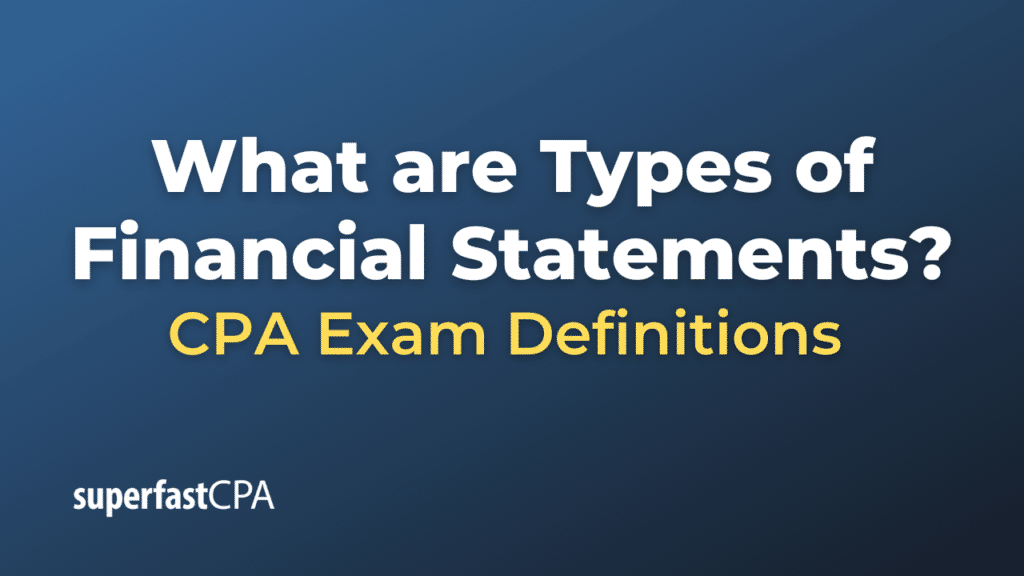Types of Financial Statements
Financial statements are formal records of the financial activities and position of a business, organization, or individual. They provide a structured representation of the financial performance and position of an entity over a specific period of time. Here are the primary types of financial statements:
- Balance Sheet (Statement of Financial Position):
- Presents the financial position of an entity at a specific date.
- Lists assets, liabilities, and shareholders’ equity.
- The basic accounting equation here is: Assets = Liabilities + Shareholders’ Equity.
- Income Statement (Profit and Loss Statement):
- Cash Flow Statement:
- Provides information about an entity’s cash inflows and outflows over a period of time.
- Segmented into three categories:
- Operating activities: Related to core business operations.
- Investing activities: Related to acquisition or disposal of long-term assets.
- Financing activities: Related to changes in equity and borrowings.
- Statement of Changes in Equity (Statement of Retained Earnings):
- Shows all changes to the equity section of the balance sheet during a period.
- Includes new equity issuance, dividends, share buybacks, and changes in retained earnings due to net income or loss.
- Notes to Financial Statements:
- Provide additional detail and context to the above statements.
- Include information on accounting methodologies, assumptions, and other essential details that aren’t presented in the primary statements.
- Statement of Comprehensive Income (often combined with the Income Statement):
- Displays items that are not included in the net profit or loss for the period but may be realized in future periods, such as currency translation differences or unrealized gains/losses on certain investments.
These statements are interrelated and are typically prepared in the order listed above. They are essential for various stakeholders, such as management, investors, creditors, regulators, and analysts, who rely on these statements to assess the financial health and performance of a business.
Example of Types of Financial Statements
Let’s create a simplified example for a fictional company named “TechGlo Innovations” for the year ending December 31, 2023.
1. Balance Sheet (as of December 31, 2023)
- Assets:
- Current Assets:
- Cash: $50,000
- Accounts Receivable: $20,000
- Inventory: $30,000
- Non-Current Assets:
- Property, Plant, & Equipment: $100,000
- Current Assets:
- Liabilities:
- Current Liabilities:
- Accounts Payable: $25,000
- Long-term Liabilities:
- Long-term Debt: $40,000
- Current Liabilities:
- Equity:
- Common Stock: $50,000
- Retained Earnings: $85,000
2. Income Statement (for the year ended December 31, 2023)
- Revenues: $200,000
- Cost of Goods Sold: -$120,000
- Gross Profit: $80,000
- Operating Expenses: -$50,000
- Net Income: $30,000
3. Cash Flow Statement (for the year ended December 31, 2023)
- Operating Activities:
- Net Income: $30,000
- Increase in Accounts Receivable: -$10,000
- Increase in Inventory: -$5,000
- Increase in Accounts Payable: $5,000
- Net Cash from Operating Activities: $20,000
- Investing Activities:
- Purchase of Equipment: -$20,000
- Net Cash used in Investing Activities: -$20,000
- Financing Activities:
- Proceeds from Long-term Debt: $40,000
- Net Cash from Financing Activities: $40,000
- Net Increase in Cash: $40,000
- Beginning Cash: $10,000
- Ending Cash: $50,000
4. Statement of Changes in Equity (for the year ended December 31, 2023)
- Opening Balance of Retained Earnings: $55,000
- Add: Net Income for the year: $30,000
- Ending Balance of Retained Earnings: $85,000
5. Notes to Financial Statements
- The company adopted the new accounting standard XYZ in 2023.
- Property, Plant, & Equipment are depreciated over a useful life of 10 years using the straight-line method.
This is a very basic representation of financial statements. In real-world scenarios, financial statements of companies are much more detailed, complex, and accompanied by extensive notes providing additional explanations and breakdowns.













